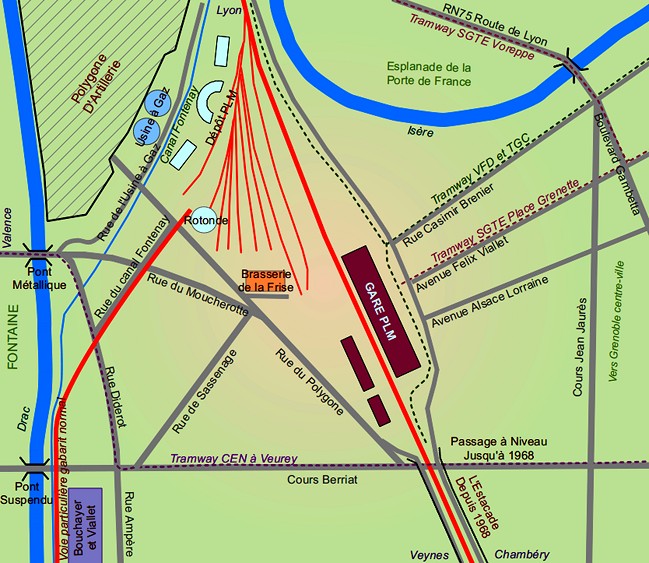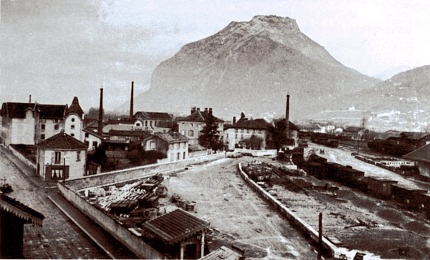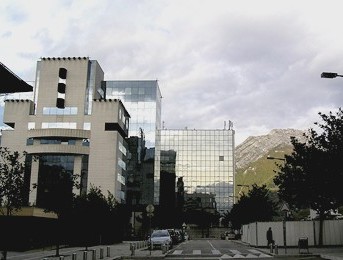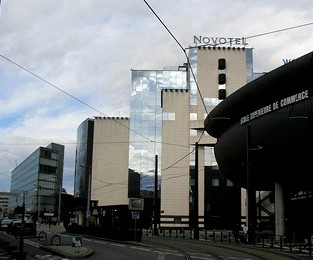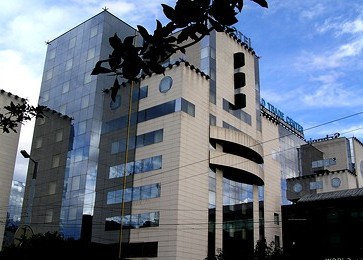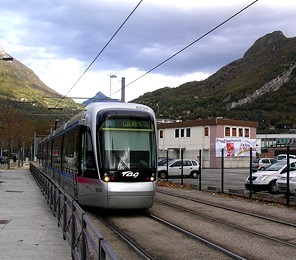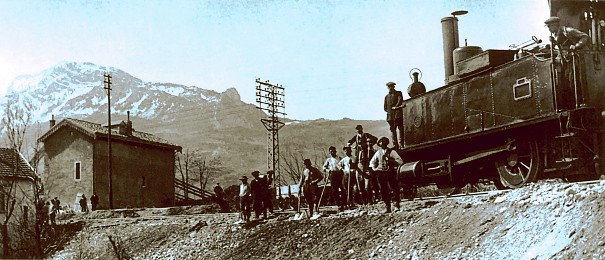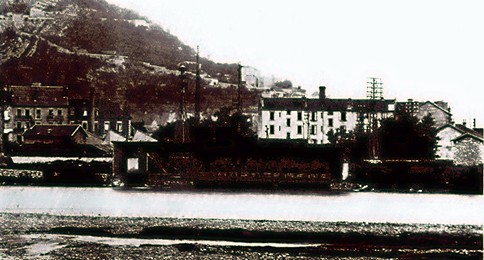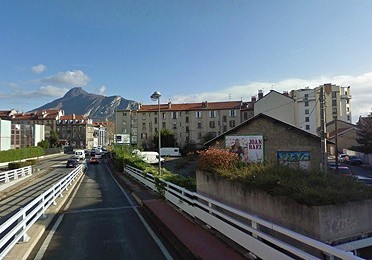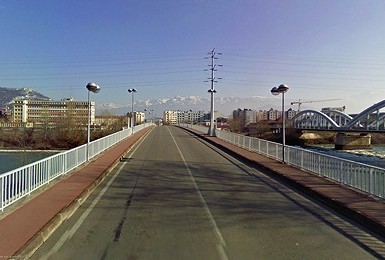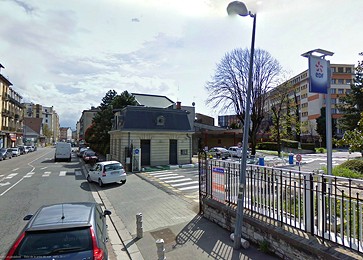Grenoble -around the Railway.
4- Around and about the Railway Station, Drac side.
-disused,
forgotten, taken away or
abandoned lines.
4- Around and about the Railway Station, Drac side.
All
the pictures can be enlarged with a mouse click!
The Dauphine Railway Company would have liked to build
it's station on the esplanade of the 'Porte de France', but the
military
administration was opposed to that. The land proposed for its
construction was out of town not far from the polygon firing
range.
To compensate for the distance from the train station to the town centre, an excellent electric tram service were introduced in 1900. There was even a tram which crossed the Drac by a metal bridge to serve Fontaine, Sassenage, Noyaray and Veurey. This tram crossed the railway line to Veynes by the Berriat level crossing. From 1911, another tram following the same route went to Seyssins and nine years later, the train even got up to Villard de Lans. This train was the renowned GVL.
There were many factories in the area, the best known was probably Bouchayer & Viallet, which even had its own branch line that followed the Drac dyke up to the 'Rondeau'.
Near the railway sidings and the freight station, there was the Frise brewery which produced beer up until 1957. In 1965 the circular rotunda, built by the PLM company for it's steam trains, was demolished. With the hosting of the Olympic Games in 1968, the old station was replaced by a more modern station with lots of glass. At that time the 'Estacade' viaduct is built on the level crossings Berriat, Jean Jaurès and Aigle.
In 1978 the storage sheds and workshops are in turn removed to make way for the new Europole business district.
To compensate for the distance from the train station to the town centre, an excellent electric tram service were introduced in 1900. There was even a tram which crossed the Drac by a metal bridge to serve Fontaine, Sassenage, Noyaray and Veurey. This tram crossed the railway line to Veynes by the Berriat level crossing. From 1911, another tram following the same route went to Seyssins and nine years later, the train even got up to Villard de Lans. This train was the renowned GVL.
There were many factories in the area, the best known was probably Bouchayer & Viallet, which even had its own branch line that followed the Drac dyke up to the 'Rondeau'.
Near the railway sidings and the freight station, there was the Frise brewery which produced beer up until 1957. In 1965 the circular rotunda, built by the PLM company for it's steam trains, was demolished. With the hosting of the Olympic Games in 1968, the old station was replaced by a more modern station with lots of glass. At that time the 'Estacade' viaduct is built on the level crossings Berriat, Jean Jaurès and Aigle.
In 1978 the storage sheds and workshops are in turn removed to make way for the new Europole business district.
The private branch
lines on the Drac dyke.
On the site of the old dike, there is now the A480 motorway, so
there is no trace of the old railway track. Of course if you look at
the photo below, you can see the Moucherotte with it's three maidens.
But also, we see the cables of the old suspension bridge, replaced in
1937 by the current cast concrete bridge.
Réseau ferré, Victor Fusero.
(Memoires de Viscosiers, Pelon, Ricard et Silhol. PUG, 1989.)
(Memoires de Viscosiers, Pelon, Ricard et Silhol. PUG, 1989.)
"There was a railway line which followed the Drac: it began at Esclangon Street, at the Vicat Cement works, following the Fontenay Canal. First it served Bouchayer and Viallet, and all kinds of businesses as far as the Viscose factory in the Rondeau district.
-------- The locomotive went along the Drac, from Bouchayer & Viallet, which received paper pulp, coal or tanks of chemicals like sodium sulfide. For Scarangella, the driver, it was his love. At five in the morning he was there, polishing the brass. "
found in , 'Une Industrie dans la ville, Bouchayer & Viallet à Grenoble de Hervé Bienfait, Libris 2004.
The Fontenay Canal.
This was created in 1869 to power the PLM workshops. Now it is buried
in a big pipe under Esclangon street. The 1925 photograph shows the
entrance to the canal in a straight line with the Bastille Fort.
Comparing it with current pictures, we have the pleasure to discover
the presence of several apartment blocks which have survived. The EDF
Grenoble headquarters are on the location of the industrial buildings
on the left. This may have been a power station judging from the
chimney!
Extract from 'Le Bassin du
Drac',
Auguste Bouchayer, 1925.
".........
we read in an anonymous report that the level of the Drac at the
suspension bridge, or rather the beginning of the curved dike, was
several feet above the Isère at the 'Porte de France'. The possibility
of using this energy potential was tempting engineers. In 1869, the
Dauphiny Railway Company, who's director was Tony Fontenay, bought the
land from the railway station. The company, whose station was at Saint
Égrève, wanted to transfer to Grenoble and had to make a small canal to
supply motive power for its repair shops. Meanwhile the PLM Company had
acquired the Dauphiny Railway Company and Tony Fontenay thought of
building a big canal between the Drac and the Isère to provide a force
of 500 horsepower. He asked the PLM to rent the land on which part of
the channel should be established. A lease was signed on 1st September,
1869 at a price of 900 francs to provide 8 horsepower. The Drac intake
was authorized by presidential decree on October 16th, 1871 and the
work performed and completed successfully. The construction became
known as the Fontenay Canal. "Bouchayer Auguste. Le Bassin du Drac. Revue de géographie alpine. 1925, Tome 13 N°3. pp. 549-621.
Some Internet Links:
- http://www.hannibal-dans-les-alpes.com/
- http://1900anosjours.hpsam.info/photos/grenoble/exposition-internationale-1925.php
- http://insitu.revues.org/217#tocto1n2
- http://www.rocadesud.com/realisations/?actmenu=estacade&ID_rubrique=4
- http://www.artmajeur.com/?go=artworks/display_mini_gallery&image_id=2564745&login=nesse
- http://www.arcachon-nostalgie.com/roger_expert.htm
- http://insitu.revues.org/217#tocto1n2
- http://histoire.trains-en-vadrouille.com
- http://www.euro-photos-trains.com/sncf67300BBC.htm
- http://cccp.trainprovence.free.fr/cccp/article-alpazur2007.html
- http://clode.chez-alice.fr/fretgrenoble.htm
- http://www.lineoz.net/forum/viewtopic.php?f=3&t=3657&start=0
- http://membres.multimania.fr/stephanerevel/histo.htm
- http://www.ville-st-martin-dheres.fr/industrialistation.html
- http://emmatortue.wordpress.com/2009/05/15/ces-biscuits-ont-fait-les-delices-de-mon-enfance/
- La Vie du Rail, N°'s 1104, 1129, 1131 et 1137, Éditions NM Paris, 1967 et 1968.
- Le Bassin du Drac, Auguste Bouchayer. Revue de géographie alpine. Tome 13 N°3. pp. 549-621. 1925.
- Histoire Populaire de Grenoble, Alphonse Vernet. Gratier, 1896.
- Le Chemin de Fer de Grenoble à Villard de Lans. Philippe Guirimand et Patrice Bouillon, 2000.
- Grenoble Autrefois, Jean-Jacques de Corcelles. Horvath, 1996.
- Une Industrie dans la Ville, Bouchayer & Viallet à Grenoble. Hervé Bienfait. Libris, 2004.
- L'Illustration Economique et Financière, numéro spécial, Grenoble et l'Isère, 1923.
- Les Voies Ferrées du Dauphiné, Henri Boyer et Patrice Bouillon, 1983.
- Guide Catalogue Officiel de l'Exposition Internationale de la Houille Blanche et du Tourisme, Saumane 1925.
- Grenoble Autrefois, Claude Muller, Editions des Quatre Seigneurs, 1974.
- Du Tram au Tag, JM Guétat, W Lachenal, G Muller, La Vie du Rail,1987.
